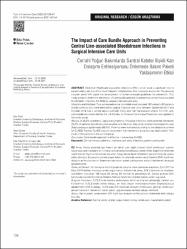The Impact of Care Bundle Approach in Preventing Central Line-associated Bloodstream Infections in Surgical Intensive Care Units
Künye
Polat, E., & Çavdar, İ.(04.11.2022) The Impact of Care Bundle Approach in Preventing Central Line-associated Bloodstream Infections in Surgical Intensive Care Units. Turkish Journal of Intensive Care, (20)3. pp. 138-147. https://doi.org/10.4274/tybd.galenos.2021.44154Özet
Objective: Healthcare-associated infections (HAI), which pose a significant risk to patient safety, are one of the most frequent complications that inpatients encounter. The growing concern about HAI urged the development of evidence-based guidelines for prevention. This study aimed to determine the impact of care bundle approach in preventing central line-associated bloodstream infections (CLABSI) in surgical intensive care units.Materials and Methods: This semiexperimental controlled study included 163 subjects (83 patients and 80 controls) who were admitted to surgical intensive care units between September 2017 and October 2018, had a central venous catheter (CVC), and met the inclusion criteria. For CVC care, care bundle recommended by the US Centers for Disease Control and Prevention was applied to the study group.Results: In 23.3% of patients, signs and symptoms of hospital infections were observed. Moreover, 25.2% of catheter tip cultures were positive, and the most frequently isolated microorganism was Staphylococcus epidermidis (58.5%). Patients were evaluated according to the diagnostic criteria for CLABSI. Further, CLABSI was not observed in the intervention group but was diagnosed in 10% (n=8) of the patients in the control group.Conclusion: Care bundle approach is effective in preventing CLABSI.

















